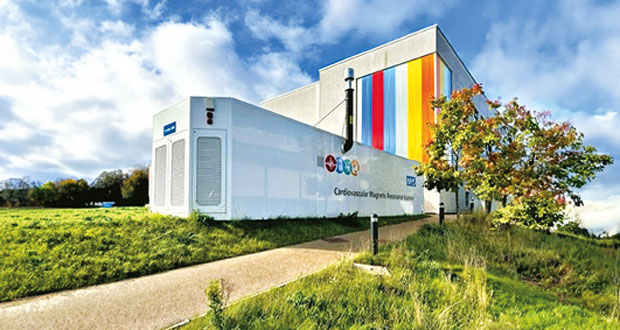 Nigel Robinson from Service Works Global explains how an integrated tech solution that includes space management software, CAFM and BIM is supporting the FM and estates team at NHS Kettering
Nigel Robinson from Service Works Global explains how an integrated tech solution that includes space management software, CAFM and BIM is supporting the FM and estates team at NHS Kettering
The Kettering General Hospital NHS Foundation Trust (NHS Kettering) has approximately 560 beds in multiple wards, covering just under 80,000m², and functions as part of the larger NHS organisation. As one of the older estates, NHS Kettering requires well-managed maintenance routines to ensure optimal levels of patient care. Its estates and facilities team numbers approximately 350 people, including maintenance, housekeeping, medical devices, porterage, and sterile services.
We have supported NHS Kettering since 2019 and provide a range of software solutions across the Trust’s estate, including computer-aided facilities management (CAFM) and Building Information Modelling (BIM).
The Trust originally partnered with SWG to improve its FM helpdesk provision and planned preventative maintenance (PPM) schedules. Since then, we have continuously expanded the scope to meet the growing needs of the UK NHS sector. Some of the key additions include space management, a mobile application for field work, and information updates for relevant compliance regulations. This has allowed for better workplace productivity and cost benefits.
BIM AND DIGITISATION
The Trust has begun digitising its estate by laser scanning smaller buildings, enabling the estates team to manage its existing building data across multiple sites. Its new state-of-the-art Energy Centre will also use this integration, following its construction.
The creation of a digital twin positions NHS Kettering as a technology leader within NHS England. A digital twin replicates all aspects of the building and its performance, forming a virtual replica of the building’s state in real time.
Not only does that mean the clinical staff function more efficiently, treat more patients, and provide a greater level of service overall, but is an example of best practice for other NHS estate teams.
COMPLIANCE ASSURANCE
Compliance standards for NHS estates have become increasingly stringent over the last decade and the Premises Assurance Model (PAM) was introduced in 2013 to help Trusts make more informed development decisions. PAM has been regularly updated in line with policy changes and user group feedback. As a result, it’s challenging to keep up to date with PAM changes if operating with an older estate.
The software is updated in line with relevant governmental guidance and compliance strategies for asset data, which matches the requirements of PAM and can be integrated with the relevant PPM schedules. This ensures that NHS Kettering can produce accurate and correct reporting to the NHS England body.
PPM AND REACTIVE MAINTENANCE SCHEDULES
By having an effective PPM schedule, hospitals can minimise the potential downtime of assets and drive better cost efficiencies. The software has enabled NHS Kettering to align more closely with SFG20 recommendations, increasing the number of PPM events. This allowed the estates team to schedule and allocate resources dynamically and comply with current regulations.
Initially, reactive works totalled approximately 1,500 a month. By analysing and performing repeat works, this has now reduced to less than 1,200 a month. Simultaneously, PPM works have increased from around 1,200 a month to 1,700. The Trust is becoming more proactive, thus reducing time of non-availability and service interruptions. It wasn’t uncommon to force cancellations of clinics or theatre due to estate service failures. The Trust have had no un-planned / un-manageable interruptions for over 12 months.
A well-managed PPM schedule also helps facilities managers to keep up with other aspects of compliance, such as Health Technical Memoranda (HTM). HTM advises on the design, installation, and operation of specialised CAFM used in the delivery of healthcare. By including HTM guidelines within the schedules, the work of the estates team will always be within the correct parameters set by NHS England.
REPORTING
Gathering building information from the official NHS England figures and internal reporting procedures can be time consuming. With QFM, SWG’s CAFM software, NHS Kettering can access real-time data. This includes clinical and non-clinical data, space utilisation data, and room availability. Two months after software implementation, NHS Kettering could identify and take steps toward rectifying areas that were causing expensive engineer visits, saving between £2,000 – £4,000 per week.
Using QFM Space data has enabled the Trust to make quicker decisions on space utilisation. Whereas previously the team would have had to visit an area, it now can perform a desktop feasibility and determine suitable areas to accommodate clinical services.
THE FUTURE
By starting small and developing the scope over time, we have created a building system that caters to the specific needs of a diverse NHS estate.
Says Edward Payne, Chief Engineer at Kettering NHS: “The development journey we have gone on with SWG has been positive from the very start. I cannot urge other NHS Foundation Trust leaders enough to begin their journey with this technology, having transformed the way we work at Kettering General Hospital for the better.”
We are now working with the Trust to integrate housekeeping and portering systems to help the estate teams with their activity scheduling. Once this integration is complete, information about room schedules and maintenance work will be accessible from one central location. As the functionality has scaled up the Trust has achieved greater efficiencies which has substantially increased the ROI.





